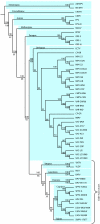Identification of multiple independent horizontal gene transfers into poxviruses using a comparative genomics approach
- PMID: 18304319
- PMCID: PMC2268676
- DOI: 10.1186/1471-2148-8-67
Identification of multiple independent horizontal gene transfers into poxviruses using a comparative genomics approach
Abstract
Background: Poxviruses are important pathogens of humans, livestock and wild animals. These large dsDNA viruses have a set of core orthologs whose gene order is extremely well conserved throughout poxvirus genera. They also contain many genes with sequence and functional similarity to host genes which were probably acquired by horizontal gene transfer.Although phylogenetic trees can indicate the occurrence of horizontal gene transfer and even uncover multiple events, their use may be hampered by uncertainties in both the topology and the rooting of the tree. We propose to use synteny conservation around the horizontally transferred gene (HTgene) to distinguish between single and multiple events.
Results: Here we devise a method that incorporates comparative genomic information into the investigation of horizontal gene transfer, and we apply this method to poxvirus genomes. We examined the synteny conservation around twenty four pox genes that we identified, or which were reported in the literature, as candidate HTgenes. We found support for multiple independent transfers into poxviruses for five HTgenes. Three of these genes are known to be important for the survival of the virus in or out of the host cell and one of them increases susceptibility to some antiviral drugs.
Conclusion: In related genomes conserved synteny information can provide convincing evidence for multiple independent horizontal gene transfer events even in the absence of a robust phylogenetic tree for the HTgene.
Figures



References
Publication types
MeSH terms
Substances
LinkOut - more resources
Full Text Sources

